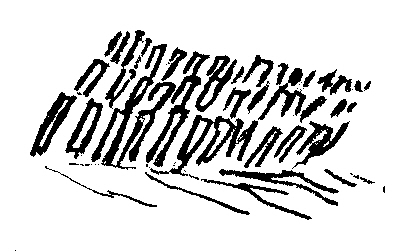| 1. Ag ullachadh na talmhainn airson mòine a bhuain |
| poll mònadh | peat bank. |
| ’rùsgadh | cutting the top layer of turf. |
| rodaigeadh | cutting a straight line with a spade, marking the breadth of turf to be taken off. |
| fèannadh | cutting underneath the turf. |
| ceap () | [masc.] a piece of turf usually three spades’ breadth wide by one across by one in depth.
|
| a’ càradh nan ceap | laying the turf neatly grassy side up inside the peat bank. This arrangement actually improves the growth of grass. |
| 2. A’ buain na mònach; na h-innealan a chleachdar; ainmean nam fàdan, etc. |
| teireisgeir () | [masc.] peat iron. Has three main parts: ‘iarunn’ i.e. the blade; ‘cas’ i.e. handle and ‘smeachan’ i.e. foot-rest, for the right foot (a chas dheas) to press the implement down.
|
| an carcaire | the part of the peat bank with the turf removed, i.e. the part to be cut.
|
| am barrad (am barr fhad) | the top peat, i.e. the first layer to be cut. |
| an corrod | the very fist peat cut. As it comes out of the face of the ‘carcaire’ [q.v.] the outside has been exposed to the elements since the last cutting the previous year. Consequently it is not so good and sometimes discarded (Tha e chòrr.) |
| an caoran | the last layer of peat; or the bottom layer, usually of less depth than the ones above it; generally hard and black. ‘Iarraidh an caoran-dubh a gharadh mu’n gar e fhein càch.’ |
| mòine dhubh | always hard, good quality. |
| moine bhan | usually soft, light and not so good. (The word used in Kintyre to describe this kind of peat is ‘phozy’.) |
| moine dhonn | good quality, not brittle. |
| moine chòsach bhàn | light and ‘phozy’, not good. |
| moine phlòiteanach | light and ‘phozy’, not good. |
| plòitean | fibry, brown material in peat. Pockets of it are sometimes found in quite hard peat. It used to be smoked in home-made pipes by boys. The pipes were either made of potato hollowed out with a stem of ‘cuiseag’ (docken plant) or of a section from a cabbage stem (the tough part above the ground was best) with the ‘cuiseag’ stem: piob phuntàt and piob chàil. |
| 3. A’ tiormachadh na mònach |
| rùdhadh | setting the peats up on end in groups of five or six, with one peat flat over the top of the others, like a ‘crom-lech’ to ward off the rain, a kind of cap. Each group is a ‘rùdhan’. This is called ‘fittin’’ the peats in Kintyre. A lady from Shetland visiting recently used this term fittin’ – probably from ‘footing’. |
| cruachadh | fairly big heaps of peat after drying off in the ‘rùdhan’. |
| cruach mhor | [See cruachadh] |
| cruach stéidhidh | a very big heap of peats with the outside layer carefully built, one peat overlapping another like slates of a house, to ward off the rain. When a year’s supply is carted home, it is finished off in this manner, although some people favour the ‘side on’ method of ‘stéidheadh’, e.g.
|
| tughadh | covering the stacks with turf for the winter. The turf is the ‘cip’ (ceap, Sing.; cip, Plural) cut off the ‘carcaire’ [q.v.] and fairly dry; used grass-side in, i.e. next the peats. Tha a’ mhòine a’ tiormachadh anns a’ chruaich. Cha bhithear a tuthadh [sic] nan cruach gu bith mhoine an ìre mhath tioram. Tha i n uairsin ‘fo laidh’ [q.v.] airson a Gheamhraidh. |
| fo laidh | safe under cover. This may be a Lewis expression. It rhymes with ‘tigh’ as pronounced in Lewis. The ‘l’ is single as in ‘loch’. I’m not at all sure of the spelling. |
| 4. A’ cruachadh na mònach |
| 5. A’ toirt na mònach dhachaigh; an cliabh, etc. |
| cliabh |
|
| iris |
|
| briagan |
|
| sprid (spridean) | [fem.], [pl.] the end of the ‘iris’ [q.v.] fitted over the ‘sprid’. This kept the ‘iris’ from pulling out. |
| bachalaibh (pronounced bachaloo) | a small creel. |
| dronnag | a coarse skirt which was rolled up round the waist and arranged as a cushion below the creel. This ‘cushion’ was the ‘dronnag’. The skirt was ‘còta-dronnaig’. |
| cuaran () | [masc.] stockings with thick soles of cloth, or perhaps socks folded up, sewn on. Worn by the women. |
| osan () | [masc.] stocking with the sole cut off, leaving the top of the foot on. This top part was kept in place by means of a loop of woollen thread (many threads twisted together) which fitted over the two middle toes. |
| cabar | when a new creel was being made, the stakes (of willow) were called ‘cabair’. Cabair a’ chleibh. |
| caol | willow. |
| caol-fighe | willow for weaving the sides of a creel or basket. |
| caol-dubh | [willow] found growing wild. Sometimes used [for weaving the sides of a creel or basket] when there was no other. |
| ceap or ceap cleibh | a square frame with holes to hold the ‘cabair’ [q.v.] when making a creel. |
| ceap-iarainn | cobbler’s last. |
| ceap starra | a cross piece of wood at the door as one came in. It was underfoot. |
| ceap-mullaich | topmost turf. To go one better than anyone else. Chuir thu ceap mullaich orra. |
| [note] | (Sorry for the digression and not keeping to the strict headings of the faclan.) |
| 6. Seòrsachan mònach |
| 7. Faclan eile |







